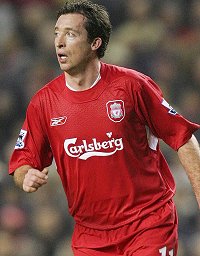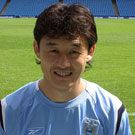Robbie Fowler
Robbie Fowler - Liverpool - Profile 2005/06
Robbie Fowler
Squad Number: 11
Position: Forward
Place of Birth: Toxteth, England
Date Of Birth: 09/ 04/ 1975
Height: 5’11
Weight: 12st 10lbs
This Season
Appearances: 7(9)
Goals: 6
Yellow Cards: 1
Red Cards: 0
Minutes on Pitch: 678
Robbie Fowler made a shock return to Liverpool after Manchester City agreed to allow him to leave on a free transfer in January 2006.
The former England striker agreed an initial contract running until the end of the campaign, but Liverpool boss Rafael Benitez will review his situation in the summer.
“If I am honest I didn’t ever really believe I would come back,” said Fowler.
“But obviously since I left, deep down I have always wanted to come back and it has been a long time, but I am glad to say I am back now.”
“Leaving was probably one of my biggest regrets I have had in football. It will be nice to get back out at Anfield wearing the red shirt again. Just to walk back out the tunnel will be amazing.”
“You put on the red shirt again and it is just an amazing feeling and I am glad I am going to get that opportunity again.”
Liverpool born Fowler was born on April 9, 1975 and was brought up in the Toxteth area of Liverpool. As a youngster he was an ardent Everton supporter. While at Nugent secondary school he was selected for Liverpool Schools’ Under-14 team and was spotted by Liverpool scout Jim Aspinall. He began training with Liverpool once a week and signed schoolboy forms with the club. Two years later he signed on as a YTS trainee and turned professional in April 1992 on his 17th birthday.
Fowler scored on his first-team debut during Liverpool’s 3-1 win in a first-round Coca-Cola Cup tie at Fulham in September 1993, but it was his five goals in the second leg at Anfield two weeks later that made everyone sit up and take notice. That haul made him one of only four players in Liverpool’s history to score five in a senior fixture, laying early foundations for his development into a Kop idol.
Seasons came and went at Anfield and scoring records werer broken. Fowler’s statistics make fantastic reading. He scored his first League hat-trick against Southampton in only his fifth League game and his first 13 games for the club yielded 12 goals. A hairline fracture of his ankle kept the young striker out for 2 months in his first season, but he still finished as their leading scorer with 18 goals.
Fowler scored the Premier League’s fastest-ever hat-trick in 4 minutes 32 seconds against Arsenal during the 1994/95 season, then picked up the PFA Young Player of the Year award at the end of a campaign that also saw him receive a Coca Cola Cup winners medal. He was also comfortably the club’s leading scorer again with 31 goals, becoming the first Anfield player for six years to top 30 goals.
Despite being left-out of the side at the beginning of the 1995/96 season in favour of Rush and Collymore, he still finished as Liverpool’s top striker, scoring 36 goals in all competitions, and helping Liverpool to an FA Cup Final appearance. Fowler was rewarded with a full England cap in April 1996 against Croatia and subsequently played in the European Championships. He followed this with 31 goals in the 1996/97 season, though injury forced him out of the start of 1997/98.
Injuries have played a key part in Robbie Fowler’s career in the past few seasons and his goalscoring tally at Anfield never again reached the heights of the first few years of his Liverpool career. Nonetheless, he was made Liverpool’s vice-captain and, in the absence of injured skipper Jamie Redknapp, performed the leadership role admirably in Liverpool’s five-trophy-winning season.
Rumours of ongoing problems with Gerard Houllier and, in particular, assistant Phil Thompson were rife and Fowler was struggling for first-team football behind the preferred partnership of Owen and Heskey. Liverpool accepted a £12million bid from Chelsea for the striker in the 2000/01 season but Robbie opted to stay and fight for his place.
But then at the end of November 2001 his career was given a boost when he made the heart-wrenching decision to finally leave Anfield and join Leeds United in a deal thought to be worth £11million. Working with the likes of Viduka, Keane and Kewell was just too good an opportunity to miss.
Unfortunately, injuries and controversy again plagued him at Elland Road, and though he still had an excellent scoring record, he missed too many games to make a real impact at Leeds. So, when Manchester City came calling in January 2003, Terry Venables was happy to let them talk to Fowler.
However, despite agreeing terms and passing a medical, the striker stunned both City and Leeds by turning down the move at the last minute. Just over a week later, he changed his mind again, and agreed to the move, and finally joined City with just over a day left in the transfer window.
Kevin Keegan was hoping that Fowler could stay injury-free and forge a partnership with Nicolas Anelka which would realise his dream of a top six finish in the Barclaycard Premiership. However, with just two goals in 13 games, Fowler did not get off to a great start at Maine Road, and City were expecting much more for the 2003/04 campaign.
Things picked up for Fowler. His form improved as his fitness did and he ended up scoring ten goals during the entire season.
His 2004/05 season was more consistant as he managed a clock up 33 appearances and score 11 goals. However, his season will be best remembered for a missed penalty in the final seconds of the final game of the season againt Middlesborough. If he had scored it, City would have qualified for next seasons UEFA Cup. As he didn’t, 'Boro went through instead.
In the 2005/06 season, he made a brief return to form, scoring a hat-trick in a 3-1 FA Cup Third Round victory over Scunthorpe and the third in another 3-1 victory over rivals Manchester United, before he made his surprise return to his spiritual home.















